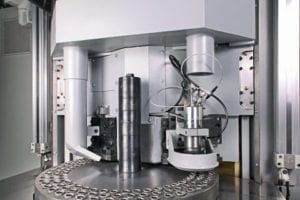 Spring grinding is a common industrial process that shapes the end coils of springs flat and square for certain applications. In general, due to their coiled ends, the overwhelming majority of spring grinding processes are performed on compression springs. The coil ends of the spring may have to be squared for a spring to mate flush with a flat surface or to simply stand straight. Grinding may also be necessary to maintain consistent lengths or for the spring to exert uniform pressure on a flat surface.
Spring grinding is a common industrial process that shapes the end coils of springs flat and square for certain applications. In general, due to their coiled ends, the overwhelming majority of spring grinding processes are performed on compression springs. The coil ends of the spring may have to be squared for a spring to mate flush with a flat surface or to simply stand straight. Grinding may also be necessary to maintain consistent lengths or for the spring to exert uniform pressure on a flat surface.
Compression springs are those familiar open-coil helical springs. They serve numerous industrial applications and are essential components for the automotive, aerospace, building, manufacturing, medical, and technology-related industries.
As its name implies, a compression spring’s mechanical energy is stored when it is compressed or, more precisely, the spring resists compressive forces when pressure is applied upon it. They are used to release or store energy while maintaining or absorbing shock between two surfaces. Compression springs hold a constant form and come in all types of designs and a variety of shapes—convex, concave, tapered, conical or cylindrical—as well as sizes from small and micro compression springs to large, heavy-duty compression springs.
The Spring Grinding Process
Spring grinding is a finishing process related to a compression spring’s intended use. Spring finishing is necessary to alter a spring’s original design to benefit its future application. For example, strength peening is a finishing process that helps steel springs resist cracking and metal fatigue after high or repeated flex cycles. Springs can also be coated, finished with a non-corrosive paint, dipped in liquid rubber, or more commonly plated with a corrosion-resistant metal such as zinc or chromium. Grinding the ends of compression springs flat is designed to allow it to more easily attach to other surfaces.
Grinding of compression springs is by design—literally and figuratively—for specific applications. Functionally, the coiled ends, usually made of steel spring wire, can be manufactured in a variety of shapes and forms to meet application requirements.
Because a defining characteristic of springs is determined by their ends, compression springs offer several options depending on the application. Compression springs may have open ends; open with ground ends; closed with non-ground ends, and closed ends that are squared and ground. Open-ended compression springs coils are consistent without any change to the pitch. Springs with closed ends that are not ground have a reduced pitch where the end coils touch. Open with ground ends, the last coil tip is flattened. Closed-end types of compression springs are flat in appearance and have parallel ends.
Spring grinding of compression springs is a specialty process that requires expertise. It’s important to consult with an expert to calculate the exact configurations that will work best for the intended application. James Spring & Wire is a custom spring manufacturer that produces an array of products for a wide range of industries. We offer an assortment of configurations from complex designs down to the basic cuts. Oftentimes, customers and potential customers come to us looking for custom spring solutions for their applications. We not only manufacture springs but also offer spring end configuration and surface grinding in-house, to streamline the spring manufacturing process. Contact us today to learn more!

